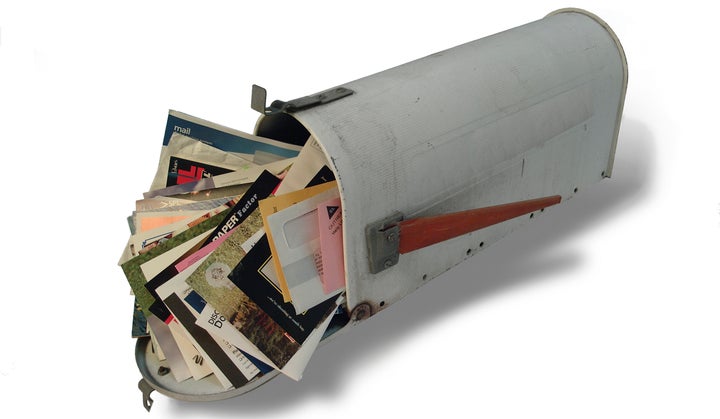
Do you ever wish your snail mail came with a spam filter?
Your mailbox, once the place of joyous discoveries like a handwritten letter or an unexpected paper check from a distant relative, is now the site of unwanted clutter. What can you do to basically stop junk mail from annoying the living daylights out of you?
Here are four ways to reduce the volume of unwanted mail delivered by USPS:
1. Opt out of prescreened credit card and insurance offers.
Call toll-free 1-888-5-OPT-OUT (1-888-567-8688) or visit optoutprescreen.com and you can choose not to receive unsolicited offers for new credit cards and insurance. This free opt-out service is operated by the four major consumer reporting companies and generally gets high reviews for effectiveness ― unlike, say, the national Do Not Call Registry, which hasn’t stopped the proliferation of unsolicited spam calls.
Consumers can block prescreened credit card and insurance offers for either five years or permanently. To do so will require that you provide certain identifiers, including your Social Security number, birthdate and home telephone number. You can also reverse an opt-out, should you wish to receive offers again.
Keep in mind that these offers are more than just a paper annoyance: When preprinted with your personal information, they can pose a financial risk to you if your mail falls into the wrong hands, since a fraudster may be able to open accounts in your name without your knowledge. It isn’t the most popular form of identity theft around, but it does happen, says the Federal Trade Commission.
2. Tell the Data and Marketing Association to bug off.
Much of the junk mail we get is from members of the DMA, the largest U.S. data and marketing association. The DMA includes nonprofits and others who market goods and services directly to consumers. In 1971, the group launched DMAchoice as a way for recipients to screen what they want to get. The DMA will allow you to opt out of entire categories of mail, such as catalogs.
The program costs $2, but will block unwanted DMA mail for 10 years. It also offers registration for DMA’s eMail Preference Service, which reduces unsolicited commercial email.
Just keep in mind that not all unsolicited mail is evil or even unwanted. For example, if you just bought a home, you likely will start receiving a torrent of discount offers from home improvement, furniture or appliance stores. A 20 percent off coupon at Home Depot or Lowe’s or Target can come in handy, and the odds that you will be shopping in those stores are high. A new baby will likely lead to offers for discounts at baby and toy stores; a retirement will flood your mailbox with offers from cruise lines, financial planners, timeshare presentations and mortuaries. Yes, mortuaries.
There is evidence that this type of mail works, which means it isn’t going away anytime soon. Last year, more than 70 percent of Americans shopped direct, said the DMA. More than 80 percent of U.S. households read some or all of their advertising mail, and nonprofit organizations raised nearly $200 billion from donors through direct mail, the organization claims.
3. Ban smaller marketers and “prospect” catalogs.
While DMA may be the Goliath in the room, there are many scrappy smaller direct marketers. Valpak delivers those blue envelopes filled coupons and ads from local contractors and companies, and you can stop them from being sent to you with a few clicks. If you like some of their offerings, but don’t want them in your mailbox, you can still go to the site and print out just the coupons you intend to use. You can also unsubscribe from any RedPlum publication (now known as RetailMeNot Everyday).
If you receive junk mail from companies you’ve never bought anything from, you’re what is known as “a prospect,” and your name is on a list that’s sold or rented to companies trying to find new customers. However, if you have purchased something from a company in the past, you’re considered a customer, and there’s a good chance you may actually want them to keep sending you catalogs or discount coupons.
So basically, you want to be able to pick and choose the junk mail you actually want to receive. Catalogchoice.org is a free alternative to DMAchoice, and it allows you to unsubscribe from catalogs one at a time. It won’t unsubscribe you from catalogs and businesses you’re a customer of, but it will eliminate those for which you’re a prospect.
4. Do it yourself, piece by piece.
You can reduce the volume of credit offers, catalogs, magazine offers, donation requests, retail promotions, bank offers, and many other things. You cannot stop bills, statements, notices and political mailings, although many companies will allow you to switch to paperless billing and statements.
Political mailings can and will proliferate as Election Day nears, and there are no laws, regulations or opt-out mechanisms to prevent this from happening. One thing you can do is look near the bottom of the pamphlet or letter, since occasionally there will be a phone number you can contact to opt out of future mailings. Though political organizations are not obligated to provide an opt-out number, some still provide one.
The more cynical among us may take that postage-paid envelope intended for donations and return it with a note that we do not wish to receive further correspondence.
You can also download PaperKarma, an app that lets you take a photo of the unwanted mailing with your smartphone and then attempts to do all the unsubscribing work for you.